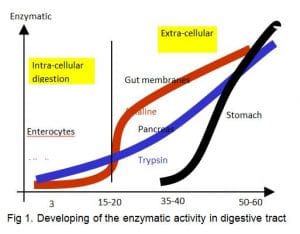Marine Larvae weaning
22 May 2019
There is an evolution in knowledge about pancreatic enzymes and hydrolyses in fish larvae as well as the mechanisms responsible for their developmental patterns.
We now have an understanding that developing artificial diets for fish larvae is more complicated than just finding the right combination of nutrients.
In recent years, aquaculture in the Mediterranean countries has been mainly based on the gilthead sea bream, Sparus aurata, and the European sea bass, Dicentrarchus labrax.
The digestibility process in these lower vertebrates is not that different from the humans.
Marine fish larvae are not completely developed at hatching and they undergo major morphological and functional changes during the first weeks of life (Cahu et al, 2004).
It remains quite unchanged from mouth opening until the completion of yolk absorption.
The larval period ends with the development of a stomach with gastric glands and pyloric caeca.
At first feeding, the digestive system is not fully functional without a stomach digestion of ingested food takes place in the larval intestine, where the pH remains alkaline and trypsin-like enzyme activity accounts for the proteolytic activity.
In some species, trypsin, aminopeptidases and alkaline phosphatase were not observed, while in other species,
such as gilthead seabream Sparus aurata and Japanese flounder Paralichthys olivaceus, phosphatase, trypsin and ATPase activities were observed 3–4 days after hatching thus the use of live food organisms, especially at first feeding, is still obligatory in marine fish larvae mass-culture (Kolkovski, 2001; D’Abramo, 2002).
Nevertheless, the live food accounts for 79% of production cost for juvenile up to 45 days old.
In the first 3 months of life it represents 50% of the feed cost even though they represented only 1.6% of the total dry weight of food required.
A viable alternative to the provision of live food is the use of micro-diets (MD), which can represent a considerable saving in production costs and infrastructure, as well as offering nutritional consistency and off-the-shelf convenience. (Kolkovski, 2001).
A fully developed digestive tract (including gastric digestion) develops during metamorphosis and is represented in summary in Figs 1 and 2.


The digestion of nutrients occurs then in the gastrointestinal tract and is performed by the enzymes of the stomach, exocrine pancreas and intestine but also includes the absorption/transport of nutrients by the intestinal cells (Zambonino and Cahu, 2001).
Conversely, the small size and rudimentary development of larvae of marine species and some freshwater species have hampered the success of weaning the fish onto a prepared MD at an early age.
Although weaning can be achieved at metamorphosis or 0.5–0.75 g in most species, the earlier introduction of MD as the sole replacement for live food had only limited success.
The poor performance of MD is related to the inadequate incorporation of nutrients due to poor ingestion, digestion and or assimilation.
The relatively low level of enzyme activities and the absence of pepsin-like enzyme activity has been considered as one of the reasons for the limited success of MD and the poor growth of larvae fed solely on MD.
During recent years, intensive research has been conducted to find full or partial replacements for live food organisms.
Although significant improvement was reported in co-feeding live and dry diets, especially at the Artemia stage, MD have not, at this stage, matched the growth and survival demonstrated by fish fed with live feeds such as rotifers and Artemia nauplii.
BernAqua success in larval rearing is based in following the scientific community and these studies.
Our larval feeds Caviar and Nori are known to achieve very high levels of digestibility in very young larvae (up to 96%) and thus are able to largely reduce artemia consumption during the larval phase.
Although by using these feeds you can partially achieve your goals of reducing live food food consumption, we decided to go further and have recently decided to introduce to the market the Vitellus.
Vitellus is made of artemia cysts extract (yolk platelets), which are considered among the most perfect natural microcapsules.
With a simple agglomeration process, we incorporate our knowledge about enrichment of live preys.
This makes of the Vitellus a partially enriched live food presented as a dry product, which will allow for further savings in the preparation and use of the costly live food.
For more information about this product and protocols don’t hesitate to contact us.

